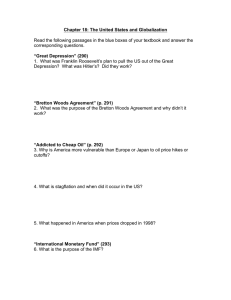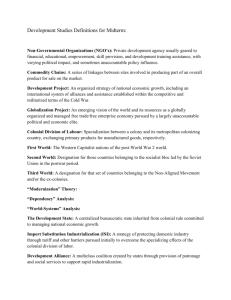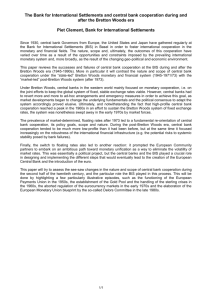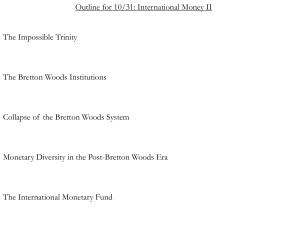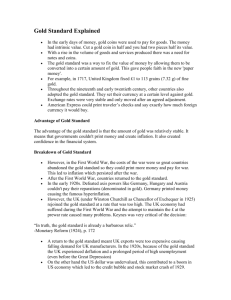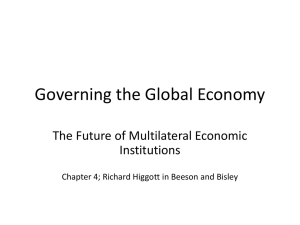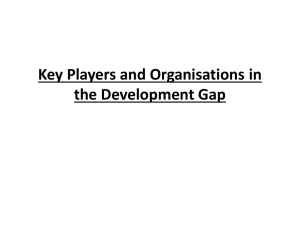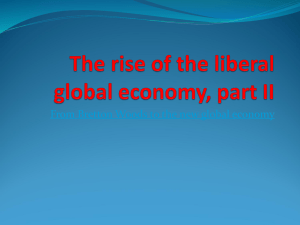Introduction to International Economic Law
advertisement
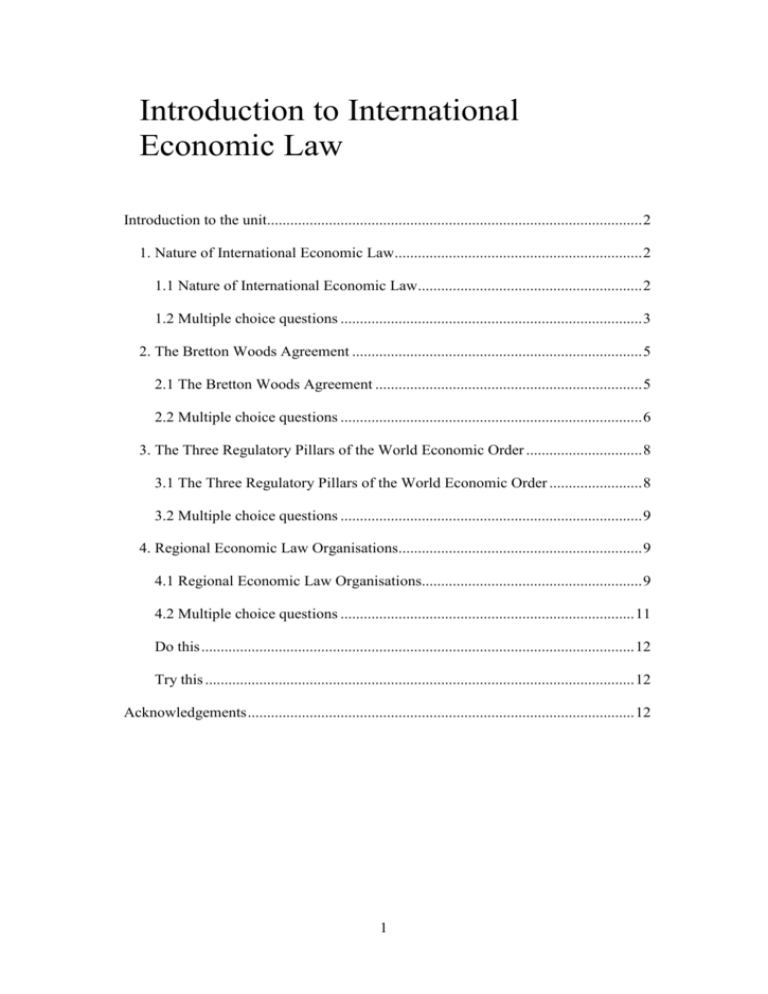
Introduction to International Economic Law Introduction to the unit................................................................................................. 2 1. Nature of International Economic Law................................................................ 2 1.1 Nature of International Economic Law.......................................................... 2 1.2 Multiple choice questions .............................................................................. 3 2. The Bretton Woods Agreement ........................................................................... 5 2.1 The Bretton Woods Agreement ..................................................................... 5 2.2 Multiple choice questions .............................................................................. 6 3. The Three Regulatory Pillars of the World Economic Order .............................. 8 3.1 The Three Regulatory Pillars of the World Economic Order ........................ 8 3.2 Multiple choice questions .............................................................................. 9 4. Regional Economic Law Organisations............................................................... 9 4.1 Regional Economic Law Organisations......................................................... 9 4.2 Multiple choice questions ............................................................................ 11 Do this ................................................................................................................ 12 Try this ............................................................................................................... 12 Acknowledgements .................................................................................................... 12 1 Introduction to the unit This unit is an introduction to the subject of International Economic Law. It includes a historical development of the subject and refers to the principal organisations related to International Economic Law. The purpose of this unit is to increase: Familiarisation with the historical development and purpose of the most prominent institutions regulating international economics. 1. Nature of International Economic Law 1.1 Nature of International Economic Law International Economic Law deals with the regulation of economic affairs between two or more different States. This is its main function. If such regulation applies to two States only, we then speak of bilateral economic regulation. If, on the other hand, such regulation applies to more than two States, we speak of multilateral economic regulation. Beyond this, International Economic Law is seen to increasingly deal with the regulation of traders from different countries. As a result, International Economic Law has a dual character nowadays, as it deals both with the regulation of economic relations of different States but also with the regulation of traders from different countries. Activity 1 This activity should take approximately 5 minutes to complete. Click on the tabs in the animation to see the difference between bilateral economic regulation and multilateral economic regulation An animation that shows the difference between bilateral economic regulation and multilateral economic regulation. Flash content unavailable International Economic Law deals with two kinds of legal instruments: soft law instruments and hard law instruments. Hard law instruments create obligations being binding and enforceable in nature, whereas soft law instruments do not create obligations and are non-binding and generally unenforceable in nature. Activity 2 This activity should take approximately 15 minutes to complete. An animation that shows the difference between hard and soft law instruments. 2 Flash content unavailable Answer This animation shows that: A hard law instrument is for instance a binding provision such as the competition provisions of EU law. A soft law instrument is a non-binding instrument which may have to be followed such as the Articles of Agreement of the International Monetary Fund. End of answer 1.2 Multiple choice questions Now test your understanding of what this section has covered so far. The following multiple choice questions should take approximately 10 minutes to complete. Question 1 What is the subject matter of International Economic Law in the main? (a) Economic relations between States (b) Economic relations between traders of different States (c) Economic relations between traders of different States and economic relations between different States (d) Economic relations between different regional trade blocks Answer The subject matter of International Economic Law in the main is: (a) Economic relations between States End of answer Question 2 International Economic regulation can be concerned with two States only. It can also be concerned with many States. What are the terms to describe these two types of regulation? (a) Bilateral and multilateral economic regulation 3 (b) Regional and global trade block (c) Single and multiple economic regulation (d) Unipolar and multipolar trade affairs Answer The correct terms to describe International Economic regulation between two States and between many States are: (a) Bilateral and multilateral economic regulation End of answer Question 3 International Economic Law is increasingly seen to be having a dual character. This character relates to: (a) Traders and trade blocks (b) Traders and States (c) Traders and politicians (d) Traders and banks Answer International Economic Law is increasingly seen to be having a dual character, relating to: (b) Traders and States End of answer Question 4 Depending on the level of force behind an International Economic Law instrument, an instrument as such can be: (a) Hard or soft law (b) Multilateral or bilateral agreement (c) Politicised or non-politicised agreement (d) Regional or global law 4 Answer Depending on the level of force behind an International Economic Law instrument, an instrument as such can be: (a) Hard or soft law End of answer 2. The Bretton Woods Agreement 2.1 The Bretton Woods Agreement The foundations for the organisations relating to modern International Economic Law were laid in 1944 with the Bretton Woods Agreement. The Agreement was concluded by 44 Allied States. The Bretton Woods Agreement grew out of the desire to eradicate the causes that led to the Second World War, the ultimate goal being the creation of a new world economic order. Activity 3 You should expect to spend approximately 10 minutes on this activity. Explore the map using your mouse to see which countries were involved in the Bretton Woods Agreement. An interactive world map that show the countries which were involved in the Bretton Woods agrement. Flash content unavailable Answer The countries who signed the Bretton Woods Agreement were: Australia India Belgium Iran Bolivia Iraq Brazil Liberia Canada Luxembourg Chile Mexico 5 China Netherlands Colombia New Zealand Costa Rica Nicaragua Cuba Norway Czechoslovakia Panama Dominican Republic Paraguay Ecuador Peru Egypt Philippines El Salvador Poland Ethiopia Union of South Africa France Union of Soviet Socialist Republics (USSR) Greece The United Kingdom Guatemala The United States Haiti Uruguay Honduras Venezuela Iceland Yugoslavia End of answer 2.2 Multiple choice questions Now test your understanding of what this section has covered so far. The following multiple choice questions should take approximately 10 minutes to complete. Question 5 What was the name of the Agreement that laid the foundations for the creation of the WTO, the IMF and the World Bank Group? (a) The Bretton Woods Agreement (1944) (b) The Potsdam Agreement (1945) 6 (c) The Dayton Agreement (1995) (d) The Luxembourg Agreement (2003) Answer The name of the Agreement that laid the foundations for the creation of the WTO, the IMF and the World Bank Group was: (a) The Bretton Woods Agreement (1944) End of answer Question 6 What was the desire behind the Bretton Woods Agreement? (a) A desire to put an end to the Second World War (b) A desire to eradicate the causes that led to the Second World War (c) A desire for creating a system of fluctuating currencies (d) A desire for the abolition of different currencies Answer The desire behind the Bretton Woods Agreement was: (b) A desire to eradicate the causes that led to the Second World War End of answer Question 7 What was the ultimate goal of the Bretton Woods Agreement? (a) The creation of a global alliance of States (b) The creation of an economic trade block (c) The creation of a new world economic order (d) The creation of a military alliance Answer The ultimate goal of the Bretton Woods Agreement was: (c) The creation of a new world economic order 7 End of answer 3. The Three Regulatory Pillars of the World Economic Order 3.1 The Three Regulatory Pillars of the World Economic Order The Bretton Woods system gave birth to three international organisations of paramount importance for International Economic Law. These are: 1. The World Trade Organization (WTO) (the successor of the General Agreement on Tariffs and Trade) 2. The International Monetary Fund (IMF) 3. The World Bank Group These are generally perceived as the three main organisations regulating the international economic order. Activity 4 You should expect to spend approximately 10 minutes on this activity. Use this animation to find out further information about the Three Regulatory Pillars of the World Economic Order. An interaction which gives further information on the WTO, IMF and World Bank Flash content unavailable Answer The Three Regulatory Pillars of the World Economic Order include: The World Trade Organisation: The main functions of the WTO are: o To administer WTO agreements o To review trade policies of member states acting as a forum for the resolution of international trade disputes The WTO adheres to four principles: 1. Non-discrimation 2. Reciprocity eg. mutual tariff reduction 3. Transparency eg. clear unambiguous trade measures 4. Fairness eg. restrictions on dumping goods The International Monetary Fund: An international organisation which keeps the global financial nexus under inspection. The IMF does so by observing the world exchange rates and the balance of payments and multilateral payments. 8 The IMF also offers technical assistance to various countries around the world. The World Bank: A set of organisations that strive for the promotion of world development by: o Making financial resources available to governments o Making financial resources available to private enterprises o Stimulating investment flow o Providing a forum for resolving disputes arising within the areas of investment End of answer 3.2 Multiple choice questions Now test your understanding of what this section has covered so far. The following multiple choice question should take approximately 5 minutes to complete. Question 8 International Economic Law is primarily concerned with certain institutions of global remit. These are: (a) The ASEAN, the EU and NAFTA (b) The WTO, the IMF and the World Bank Group (c) The UN and the International Court of Justice (d) The NATO and the International Criminal Court Answer International Economic Law is primarily concerned with certain institutions of global remit, which are: (b) The WTO, the IMF and the World Bank Group End of answer 4. Regional Economic Law Organisations 4.1 Regional Economic Law Organisations International Economic Law is also relevant to certain regional trading blocks, as illustrated in the map below. Activity 4 9 You should expect to spend approximately 10 minutes on this activity. Use this animation to familiarise yourself with regional trading blocks: some of the most important include: The European Union The European Free Trade Area The North American Free Trade Agreement The Mercosur The Association of Southeast Nations The Asia-Pacific Economic Co-Operation An interactive map which shows the regional economic law organisations and their member states. Flash content unavailable Answer The regional trading blocks shown on the map include: The European Union: Austria, Belgium, Bulgaria, Cyprus, Czech Republic, Denmark, Estonia, Finland, France, Germany, Greece, Hungary, Ireland, Ital, Latvia, Lithuania, Luxembourg, Malta, Netherlands, Poland, Portugal, Romania, Slovakia, Slovenia, Spain, Sweden, United Kingdom The European Free Trade Area: Iceland, Norway Switzerland, Liectenstein The North American Free Trade Agreement: Canada, USA, Mexico The Mercosur: Argentina, Brazil, Paraguay, Uruguay The Association of Southeast Nations: Brunei, Darussalam, Cambodia, Indonesia, Laos, Malaysia, Myanmar, Philippines, Singapore, Thailand, Vietnam The Asia-Pacific Economic Co-Operation: Australia, Brunei, Canada, Indonesia, Japan, Republic of South Korea, Malaysia, New Zealand, Philippines, Singapore, Thailand, USA, Taiwan, Hong Kong, China, Mexico, Papua New Guinea, Chile, Peru, Russia, Vietnam The Andean Community of Nations: Bolivia, Colombia, Ecuador, Peru The Commonwealth of Independent States: Armenia, Azerbaijan, Belarus, Georgia, Kazakhstan, Kyrgyzstan, Moldova, Russia, Tajikistan, Ukraine, Uzbekistan The Association of Caribbean States: Antigua and Barbuda, Bahamas, Barbados, Belize, Colombia, Costa Rica, Cuba, Dominica, Dominican Republic, El Salvador, Grenada, Guatemala, Guyana, Haiti, Honduras, Jamaica, Mexico, Nicaragua, Panama, St. Kitts and Nevis, St. Lucia, St. Vincent and the Grenadines, Suriname, Trinidad and Tobago, Venezuela The African Union: Algeria, Angola, Benin, Botswana, Burkina Faso, Burundi, Cameroon, Cape Verde, Central African Republic, Chad, Comoros, Ivory Coast, Democratic Republic of the Congo, Republic of Congo, Djibouti, Egypt, Equatorial Guinea, Eritrea, Ethiopia, Gabon, Gambia, Ghana, Guinea, Guinea-Bissau, Kenya, Lesotho, Liberia, Libya, Madagascar, Malawi, Mali, Mauritania, Mauritius, Mozambique, Namibia, Niger, Nigeria, 10 Rwanda, Sahrawi Arab Democratic Republic, Sao Tome and Principe, Senegal, Seychelles, Sierra Leone, Somalia, South Africa, Sudan, Swaziland, Tanzania, Tongo, Tunisia, Uganda, Zambia, Zimbabwe South East Asian Association for Regional Cooperation: Pakistan, Afghanistan, Bangladesh, Bhutan, India, Maldives, Nepal, Sri Lanka End of answer 4.2 Multiple choice questions Now test your understanding of what this section has covered so far. The following multiple choice questions should take approximately 10 minutes to complete. Question 9 International economic regulation operates on two levels. Which are they? (a) Political and economic (b) Unipolar and multipolar (c) Regional and global (d) Financial and political Answer International economic regulation operates on two levels, which are: (c) Regional and global End of answer Question 10 Despite the global relevance of International Economic Law, such law is also concerned with the regulatory frameworks of certain regional trading blocks. Which are these blocks? (a) The NATO and the G8 (b) The WTO, the IMF and the World Bank Group (c) The World Intellectual Property Organization and the European Patent Office (d) The European Union, the European Free Trade Area, the North American Free Trade Agreement, Mercosur, the Association of Southeast Nations and the AsiaPacific Economic Co-operation 11 Answer International Economic Law is also concerned with the regulatory frameworks of the following regional trading blocks: (d) The European Union, the European Free Trade Area, the North American Free Trade Agreement, Mercosur, the Association of Southeast Nations and the AsiaPacific Economic Co-operation End of answer Now you have finished this unit: Do this Now you have completed this unit, you might like to: Post a message to the unit forum. Review or add to your Learning Journal. Rate this unit. Try this You might also like to: Find out more about related courses ran by the University of Derby: LL.M Commercial Law: Law of International Trade Book a FlashMeeting to talk live with other learners Create a Knowledge Map to summarise this topic. Acknowledgements Author: Antonios Platsas Image of Supreme Court building Perth, Western Australia: Photo & copy: Adrian van Leen for openphoto.net CC:PublicDomain All other written material contained within this unit originated at the University of Derby. 12
